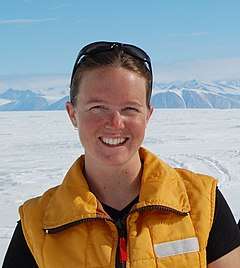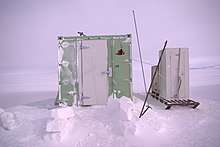Natalie Robinson
Natalie Robinson, an Antarctic researcher, is based at the National Institute of Water and Atmospheric Research in New Zealand. She led the final two K131 Science Events on the sea ice of McMurdo Sound, Antarctica.
Natalie Robinson | |
|---|---|
 Natalie Robinson on the sea ice of McMurdo Sound. | |
| Nationality | New Zealand |
| Alma mater | BSc, MSc Victoria University of Wellington PhD University of Otago |
| Scientific career | |
| Fields | Polar Oceanography |
| Institutions | National Institute of Water and Atmospheric Research |
Education
Robinson grew up in the Hawke's Bay Region and moved to Victoria University of Wellington to complete her MSc (2005) on tides beneath the McMurdo Ice Shelf with data collected during the ANDRILL project with Alex Pyne and Peter Barrett.[1] She then completed her PhD (2012) at the University of Otago under the supervision of Pat Langhorne. She now works as a research scientist at National Institute of Water and Atmospheric Research.
Career and impact
Robinson's work has significant contribution to understanding the oceanic connection between ice shelf and sea ice regimes. This has required direct sub-ice observations of pressure-induced supercooling; multi-phase fluid flow; roughness and drag at the interface; and buoyancy-driven convection.[2] She focuses on the creation, evolution and fate of supercooled water, and its potential to influence sea ice growth[3]
Robinson has led a number of field expeditions to the sea ice of McMurdo Sound, Antarctica. In 2015, she was awarded a prestigious Marsden grant, amounting to $300,000,[4] to study ice roughness beneath ice shelf affected sea ice.[5] This resulted in two expeditions to McMurdo Sound.[6][7] Her studies showed that new ice crystals could refreeze on the underside of sea ice and make the underside much rougher than under smooth melting ice.[8]
This work used Antarctic infrastructure developed by Timothy Haskell. Robinson led the final expeditions using the "K131" Camp Haskell.[9] The "K131" is an event designation assigned by Antarctica New Zealand.
She has worked with the artist Gabby O'Connor when O'Connor participated in Robinson's 2017 field expedition. This resulted in an exhibition at the Otago Museum in 2018.[10]

She is on the Council of the New Zealand Association of Scientists.
References
- Robinson, N.J., Williams, M.J.M., Barrett, P.J. and Pyne, A.R., 2010. Observations of flow and ice‐ocean interaction beneath the McMurdo Ice Shelf, Antarctica. Journal of Geophysical Research: Oceans, 115(C3). https://agupubs.onlinelibrary.wiley.com/doi/full/10.1029/2008JC005255
- "Dr Natalie Robinson". NIWA. Retrieved 2020-03-12.
- "Natalie Robinson". Natalie Robinson. Retrieved 2020-03-12.
- "Dr Natalie Robinson". Royal Society Te Apārangi. Retrieved 2020-03-12.
- https://www.nzherald.co.nz/nz/news/article.cfm?c_id=1&objectid=11540434
- https://www.stuff.co.nz/science/98902415/measuring-antarcticas-unpredictable-sea-ice-to-help-understand-climate-change
- https://www.nzherald.co.nz/nz/news/article.cfm?c_id=1&objectid=12170458
- Robinson, N.J., Stevens, C.L. and McPhee, M.G., 2017. Observations of amplified roughness from crystal accretion in the sub‐ice ocean boundary layer. Geophysical Research Letters, 44(4), pp.1814-1822.
- https://scientists.org.nz/resources/Documents/NZSR/NZSR74(3).pdf
- https://www.newshub.co.nz/home/world/2017/06/mystery-of-antarctic-sea-ice-investigated-by-science-and-art.html
External links
- Natalie Robinson's webpage
- Natalie Robinson on Google scholar